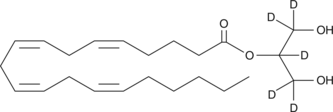| References |
| Synonyms |
|
| Formal Name |
5Z,8Z,11Z,14Z-eicosatetraenoic acid, 2-glycerol-1,1,2,3,3-d5 ester |
| Molecular Formula |
C23H33D5O4 |
| Formula Weight |
383.6 |
| Formulation |
A solution in acetonitrile |
| Purity |
≥99% deuterated product |
| Stability |
6 months |
| Storage |
-80°C |
| Shipping |
Dry ice
in continental US; may vary elsewhere
|
| SMILES |
CCCCC/C=CC/C=CC/C=CC/C=CCCCC(=O)OC(CO)CO
|
Background Reading
Kondo, S., Kondo, H., Nakane, S., et al. 2-Arachidonoylglycerol, an endogenous cannabinoid receptor agonist: Identification as one of the major species of monoacylglycerols in various rat tissues, and evidence for its generation through Ca2+-dependent and -independent mechanisms. FEBS Lett 429 152-156 (1998).
Stella, N., Schweitzer, P., and Piomelli, D. A second endogenous cannabinoid that modulates long-term potentiation. Nature 388 773-778 (1997).
Sugiura, T., Kodaka, T., Nakane, S., et al. Evidence that the cannabinoid CB1 receptor is a 2-arachidonoylglycerol receptor. Structure-activity relationship of 2-arachidonoylglycerol, ether-linked analogues, and related compounds. J Biol Chem 274 2794-2801 (1999).
| Size |
Global Purchasing |
| 50 µg |
|
| 100 µg |
|
| 500 µg |
|
| 1 mg |
|
Description
2-Arachidonoyl glycerol-d5 (2-AG-d5) contains five deuterium atoms at the 1, 1, 2, 3, and 3 positions of the glycerol moiety. It is intended for use as an internal standard for the quantification of 2-AG by GC- or LC-mass spectrometry. 2-Arachidonoyl glycerol (2-AG) is an endogenous agonist of the CB1 receptor.1,2 Unlike anandamide, 2-AG is present at relatively high levels in the central nervous system; it is the most abundant molecular species of monoacylglycerol found in rat brain.1,3 Formation of 2-AG is calcium-dependent and is mediated by the activities of PLC and DAG lipase.1 2-AG acts as a full agonist at the CB1 receptor. At a concentration of 0.3 nM, 2-AG induces a rapid, transient increase in intracellular free calcium in NG108-15 neuroblastoma X glioma cells through a CB1 receptor-dependent mechanism.2 2-AG is metabolized in vitro by MAG lipase and fatty acid amide hydrolase, with MAG lipase likely being the principle metabolizing enzyme in vivo.4
1
Stella, N., Schweitzer, P., and Piomelli, D. A second endogenous cannabinoid that modulates long-term potentiation. Nature 388 773-778 (1997).
2
Sugiura, T., Kodaka, T., Nakane, S., et al. Evidence that the cannabinoid CB1 receptor is a 2-arachidonoylglycerol receptor. Structure-activity relationship of 2-arachidonoylglycerol, ether-linked analogues, and related compounds. J Biol Chem 274 2794-2801 (1999).
3
Kondo, S., Kondo, H., Nakane, S., et al. 2-Arachidonoylglycerol, an endogenous cannabinoid receptor agonist: Identification as one of the major species of monoacylglycerols in various rat tissues, and evidence for its generation through Ca2+-dependent and -independent mechanisms. FEBS Lett 429 152-156 (1998).
4
Dinh, T.P., Carpenter, D., Leslie, F.M., et al. Brain monoglyceride lipase participating in endocannabinoid inactivation. Proc Natl Acad Sci USA 99(16) 10819-10824 (2002).
|






